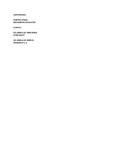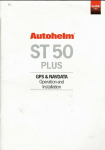Download Distributed by Any reference to Raytheon or RTN in this manual
Transcript
Distributed by
Any reference to Raytheon or
RTN in this manual should be
interpreted as Raymarine.
The names Raytheon and RTN
are owned by the
Raytheon Company.
:-
:._
.._
.
5
.
.
_I
::
”
-.:,,
-
:
._
Autohelm@
I
.
.
.
.-
.
^
.
.
-
TRIDATA & REPEATER
Operation and
Installation
-
.
. . .
:
i
i
’
-.
.
..
._
_
.
_
ST50 Plus Ttidata
and Repeater Operation and Installation Handbook
Autohelm and SeaTalk are registered Trade Marks of Nautech Limited
Autohelms policy of r.on@nl~~~lg i-np~~\pm& 2nd ydatino
1-t cl).rrw,n#“L,“t
--A+-+;--- I.3
r’--.. .m .I-MU
. . ..Jrhannn
“..I8 ‘0” nrn~
p?’ VU”“%
without prior notice
Copyright Nautech 1993
ST50 Pius Tridata and Repeater Operation and Installation Handbook
ST50 Plus Tridata and Repeater Operation and Installation Handbook
“ackage Contents
The following items are included in the ST50 Plus Tridata package:
1. ST50 Plus Tridata control head
2. Fixing studs (2 offI
3. Thumb nuts (2 offI
4. Fiing template
5. Power cable
6. Speed transducer (through hull) with 14m (45ft) of cable
7. Depth transducer (through hull) with 14m (45ftI of cable
8. Control head cover
9. Operation and Installation handbook
Autohelm
10. Worldwide Service Centre handbook
11. Warranty document
12. Securii sticker
SeaTalk
SE0 Plus Tridata and Repeater Operation and lnstalfation Handbook
Contents
Contents
Introduction .......................................................................
1
Chapter 1: Control Headlnst&tion ......................................
3
1.1 Sing ...........................................................................
3
1.2 Mounting Procedure ...................................................... .4
1.3 Power Supply (standabne operation) ................................ .6
1.4 Power Supply (SeaTalk operation) .................................... .6
1.5 Connection of Separated Instruments ............................... .7
1.6 Ring Connection ............................................................ .8
1.7 Connection to SeaTalk Compatible Autopilots ..................... .8
9
Chapter 2: Transducer Installation ........................................
2.1 Connection to the Control Head ....................................... .9
2.2 Transducer Selection ..................................................... .9
2.3 Transducer Installation .................................................. 10
13
Chapter 3: Fault Finding and Maintenance ............................
3.1 Fault Finding ............................................................... .13
3.2 Maintenance ............................................................... 14
Chapter 4: Operation ........................................................
4.1 Depth Key ...................................................................
15
16
4.2 Speed Key ................................................................... 17
4.3TripKey.. .................................................................... 18
Chapter 5: CODE LockSecwity ..........................................
21
Chapter 6: Calibration .......................................................
25
6.1 Initial Calibration ...........................................................
26
6.2 Log Calibration ........................................................... .28
6.3 Intermediate Calibration ................................................. 32
6.4 Extended Calibration .................................................... .34
Chapter 7: Connection to other Marine Equipment ................. 37
Chapter 8: GeneralSpeciticatim~ ........................................
39
ST50 Plus T&Ma and Repeater Operation and installation
Handbook
!SEOUus
Ttidata andRepeater Operation andlhstallation
Handbook
Introduction
The ST50 Plus Tridata is a multifunction instrument providing comprehensive
speed, distance, depth, sea temperature and timing information.
The instrument can be configured to operate as a master unit or a dedicated
repeater. Settings such as log, speed, depth and temperature units are
stored in permanent memory and retained even when the power source is
disconnected. The log function can be calibrated automatically over a
measured distance or by simple entry of a calculated calibration factor.
The ST50 PlusTridata also incorporates a securii feature to protect
instruments mounted in vulnerable areas such as the cockpit, helm or mast.
Thank you for purchasing an Autohelm product. May we take this opportunity
to wish you years of trouble free operation.
Chapter 1: Control Head Installation
Chapter 1: Control Head Installation
1lOmm (4.33in)
38.75mm (1.5in)
t-7
1.1 Sing
The ST50 Plus TridataRepeater is designed for above or below deck
installation where it is:
l
Easily read by the helmsman
l
Protected against physical damage
l
At least 230mm (gin) from a compass
l
At least 500mm (20in)from radio receiving equipment
l
Accessible from behind for ease of installation and cable running
caution:
To prevent moisture forming on the display window, the ST50 Plus
T~~~~e~~~ughasmallventin~cableboss.
Therefore, the control head must be sited where the rear case is
protectedfretllcontactwithwater.
S T 5 0 P l u s Ttidata a n d R e p e a t e r O p e r a t i o n a n d I n s t a l l a t i o n H a n d b o o k
The rear case is fitted with a foam gasket to form a water-tight seal between
the instrument and the selected installation face.
I
Chapter 1: Control Head Installation
Bracket Mounting
The ST50 Plus TridaWRepeater can, as an afternative, be bracket mounted
using the Autohelm Mounting Kii (Cat. No. D130).
01250
1 Cable boss 2 Feting studs 3 Thumb nuts 4 Gasket
I .2 Mounting Procedure
1. Make surethat the selected location is clean, smooth and flat.
2. Applythe self-adhesive template (supplied) to the selected location and
mark the centres for the fixing studs (2) and the cable boss (1).
3. Drill two 4mm (5/32inI clearance holes for the fixing studs (2) through
the bulkhead. Remove the template.
4. Cut the clearance hole for the cable boss (11 using a 50mm (2in)
diameter cutter.
5. Screw the two fixing studs (2) into the control head.
6. Pass the SeaTalk cable and transducer tailsthroughthe cableboss ( 1)
clearance hole.
7. Assemble the control head to the bulkhead and secure from behind
using the thumb nuts (3).
Note: Because the instrument breathes through the vent in the rear case, this
bracket is for interior use only.
Flush Mounting
A flush mounting kii is available for installations where a flush mount is required
or more desirable. Full installation instructions are provided with
the kit(Cat. No. D183).
S730 Plus Tridata
and Repeater Operation and Installation Handbook
.3 Power Supply (stand-alone operation)
Chapter 1: Con&o1 Head Installation
1.5 Connection of Separated Instruments
Separated instruments can be connected using one of the range of SeaTalk
Extension Cables. These cables are supplied with a SeaTalk connector fitted
to each end. Ajunction box can be used to join the cable ifit is cut for easier
routing or shortening.
lf preferred, any 2 core, screened cable co&m-ring to the following specifica
tion may be used instead of the SeaTalk cable.
l
5 Amp circuit breaker
S-Red
12v supply
1 . Connect the 2m (6ftI power supply cable directly to the distribution panel.
2 . Cutthecab!etolengthandconnecttheredwiretothe+12Vterminaland
screen to the OV terminal.
3. Cutbackandinsulatetheyellowwire.
4. Protect the circuit with a 5Acircuii breaker.
longerrunstothepowersupplycanbemadeusingoneoftheSeaTalk
Extension Cables.
.4 Power Supply (SeaTalk operation)
All instruments in a SeaTalk system receive power and information from the
SeaTalk bus. Each instrument has iwo SeaTalk connectors (3 pin) on
150mm (6in) tails. To supply power and information to the instrument simply
plug the tails from adjacent instruments into the ST50Tridata tails.
To transducer
22 AWG, 2 core screened cablewith a minimum copper area of 0.5mm2.
ST50
Plus Tridata
and Repeater Operation and Installation Handbook
Chapter 2: Transducer Installation
Chapter 2: Transducer Installation
.6 Ring Connection
Installations with a large number of instruments on a SeaTalk bus may require
a second ring-main connection to the power supply breaker to prevent
excessive voltage drops. Whether a second ring main is required can be
determined from the following:
2.1 Connection to the Control Head
The ST50 PlusTridata is supplied with depth and speed transducer cable
tails and connectors. These cable tails plug into the mating connectors fitted
to the 14m (45ftI depth and speed transducer cables.
Cable run upto 10m (33ft)
Single connection:
13 instruments maximum
Second connection:
26 instruments maximum
Cable run upto 20m (66ft)
Single connection:
7 instruments maximum
Second connection:
13 instruments maximum
The second ringmain should be connected to the spare lead on the last
instrument in the chain and directed back to the circuit breaker.
.7 Connection to SeaTalk Compatible Autopilots
lf the installation includes a SeaTalk compatible Autopilot the ST50 Plus
instruments may be connected to the SeaTalk bus at any point. No independ
ent connection to the 12V power supply is necessary as the instruments
receive power from the Autopilot course computer.
2.2 Transducer Selection
The type of speed transducer used is dependent on the hull material. The
following list shows the appropriate transducer for hull type.
To autopilot
SeaTalk BUS
Connection
Transducer Type
To any further
ST50 Instruments
or Autopilot
Control Units
0,134. Ll
Hull Material
Speed
.
2092 Through Hull Plastic:
GRP (Glass Reinforced Plastic), Steel and
Aluminium
ZllGThrough HullBronze:
Wood
Depth
ZO91 Through Hull Plastic:
-__ ^Lll8 I nrougn Hull Bronze:
Z120 Retractable through hull:
GRP (Glass Reinforced Plastic), Steel and
Aluminium
Wood
GRP (Glass Reinforced Plastic), Steel and
Aluminii
ST50 Plus
Tridata
Chapter
and Repeater Operation and Installation Handbook
2:
Transducer
Installation
!.3 Transducer Installation
All transducers are supplied with detailed installation and maintenance
instructions.
These instructions, together with the following notes, should be read
thoroughly before attempting to install the transducer.
‘
Sing
For accurate speed and depth readings, the transducers should be sited
within the shaded clear flow areas.
Cabling
1 . Run the cables back tothe control head.
No&Avoid fluorescent lights, engines, radio transmitting equipment etc. as
these may cause interference. Also, keep the transducer cable clear of bilges
and secure at regular intervals.
1 Sal 2 Flanning power 3Displxementpower
The transducers should also:
l
l
be ahead of the propellers (10% W.L. length minimum)
be at least 15Omm (6in) away from the keel (ideally ahead of the keel if a
sailing yacht)
l
be as near as possible the centreline of the vessel
l
be clear of otherthroughhull fittings or projections
l
have sufficient clearance inside the hull to fit the nut
l
have 1OOmm (4in) of headroom to allow for withdrawal
l
(depth transducer) be within 10” of vertical, fore, aft and athwartships.
2. Fiithetransducer and instrument cable connectors together. To lock the
connectors, push and rotate the ring onthetransducer cable connector
towards the instrument connector.
Chapter 3: Fault Finding and Maintenance
ST50 Plus Tridata and Repeater Operation and Installation Handbook
Chapter 3: Fault Finding and Maintenance
3.1 Fault Finding
,
All Autohelm products are, prior to packing and shipping, subjected to
comprehensive test and quality assurance programmes. However, if a fault
arises with the ST50 Plus Tridata, the following table will help to identify the
probable cause and provide the most likely cure.
Fault
Cause
Action
instrument display
blank.
No supply.
Check supply.
Check cabling and
security of SeaTalk
connectors.
Check fuse/breaker.
Return unit for repair.
Instrument displays
‘CODE SET
The ‘Code Lock’ feature Enter correct code
has been set.
number.
No speed or
temperature
information.
Transducer cabling
problem.
No speed information. Transducer
paddlewheel fouled.
No exchange of
information between
SeaTalk instruments.
SeaTalk cabling
problem.
Check cabling and
security of transducer
connector.
Clean paddlewheel.
Check security of
SeaTalk connectors.
Disconnect instruments
one by one to isolate
faulty unit.
Failure of a group of
SeaTalk
instruments in SeaTalk cabling/connector
chain.
problem.
Check security of
SeaTalk connectors
and non-functioning
units.
Depth reading flashes
continuously (depth
greater than 3 feet).
Transducer
cable/connector
problem.
Check cabling and
security of transducer
connector.
Depth reading flashes
while underway.
Aerated water
Boat wakes
Prop wash etc.
Normal reading will
return when clear of
disturbed water.
S T 5 0 P l u s Tridata a n d R e p e a t e r O p e r a t i o n a n d I n s t a l l a t i o n H a n d b o o k
.2 Maintenance
Chapter 4: Operation
As it leaves the factory the ST50 Plus Tridata is set to:
Instrument
Certain atmospheric conditions may cause condensation to form on the
control head window. This will not ham-r the instrument and can be cleared by
increasing the illumination setting to Level 3.
Chemical and abrasive materials must not be used to clean the ST50 Plus
Tridat@epeater instrument; if it is dirty, clean with a soft, damp cloth.
Transducer
Refer to the Installation and Maintenance instructions supplied with the
transducer.
Cabling
ChaDter 4: ODeration
., . .
Examine all cables for chafing or damage to the outer shield and, where
necessary, replace and resecure.
Advice
For advice, or further information regarding the installation of this product,
please contact the Autohelm product Support Department or your own
National Distributor.
l
display speed in knots
l
display depth in feet
l
display distance in miles
l
master mode
l
‘CODE Lock’ switched off
Other factory default settings are:
l
shallow alarm set at 10 feet (disabled)
l
deep alarm set at 100 feet (disabled)
These settings can be changed in calibration, Chapter 6.
ST50 plus Tridata
and Repeater Operation and Installation Handbook
.l Depth Key
Chapter 4: Operation
4.2 Speed Key
AVERAGE SPEED
LIGHTS
L3
SHALLOW ALARM
,
MAXIMUM SPEED
LIGHTS
L2
BOAT SPEED
1
DEPTH
,
Speed Key Notes
,. i”
The average and maximum speed displays are updated by pressing RESET
momentarily.
Note: Average speed cannot be reset on tie Tridata Repeater.
Depth Key Notes
The lights, shallow alarm and deep alarm displays will return to normal 8
seconds after the last key press.
The average and maximum speed displayswill return to normal 8 seconds
after the last key press.
ST50
Plus Tridata and Repeater Operation and Installation Handbook
Chapter 4: Operation
Trip Key Notes
3Trip Key
Timer
The countup, 10 minute and 5 minute countdown timers are started
as follows.
Count-up timer
Wth the timer legend displayed, momentarily press RESET to start
the timer.
10 minute countdown timer
Wti timer legend displayed, press RESET for 1 second to access the 10
minute timer. To startthe timer, press RESETmomentarily.
5 minute countdown timer
TIMER
With timer legend displayed, press RESET for 1 second to access the 10
minute timer and then press RESET again for 1 second to access the 5
minute timer. To start the timer, press RESET momentarily.
Freeze timers
LOG
To freeze the timer display, press RESET momentarily. Although the display
has been frozen the timer continues to count in the background.
To return to the ‘live’ timer display, press the RESET key once again.
Reset timer
SEA TEMPERATURE
(Degrees C)
SEA TEMPERATURE
(Degrees F)
The 5 and 10 minute timers are reset by pressing RESET for 1 second. The
countup timer is reset as follows:
l
Press RESET for 1 second to select the 10 minute timer.
l
Press RESm again for 1 second to select the 5 minute timer.
l
Finally, press RESETfor 1 second to return tothe countup timer.
Tiier alarms
The following alarms will sound when the 5 and 10 minute timers are running:
l
double beep every minute
l
beep three times at 30 seconds to zero
l
beep every second from 10 seconds to zero
l
beep twice when the timer reaches zero and begins to countup.
TRIP
No&The timer operates globally. That is, if you freeze the timer on the
Tridata the timer will be frozen on all other units with a timer facility.
ST50 plus Tridata
and Repeater Operation and installation Handbook
You can, once the 5 or iU mrnute countdown timer has been activated,
return to one of the main displays.The timer will continue to operate in the
background.
These alarms can be switched off if required (refer to para. 6.1, Initial
Calibration for procedures).
Trp
Trip distance is cleared by pressing RESmfor 3 seconds. During this period
the current trip distance will flash until it is zeroed.
Chapter 5: CODE Lock Security
Chapter 5: CODE Lock Security
The ST50 Plus range incorporates an anti-theft feature called ‘CODE
Lock’. Designed to protect individual instruments or complete systems in
vulnerable areas, ‘CODE Lock’ is a four digit number that you programme
into the permanent memory of a selected ‘master’ instrument.
Note: A ‘master’ instrument is a digital unit on which the code number
can be entered, and then, if part of an integrated system, transmitted to
other ST50 Plus instruments.
This facility means that, should a CODE Locked instrument be removed
from the vessel without your permission, it cannot be operated without
the four digit securii number.
‘CODE Lock’ can be used in one of three modes:
Mode 1: Off
As it leaves the factory ‘CODE Lock’ is set to off. In this mode the
instrument will operate normally when it is switched on, however, the unit
will not be protected by the anti-theft feature.
Mode 2: ‘CODE Lock’ Once-Only Enby (page 23)
This mode is designed for systems with a digital ST50 Plus instrument in
a safe, belowdecks location. This instrument can then be used as a
‘master’ to enter the four digit code number and, when the power is
switched on, automatically transmit the code to all the instruments in the
system. The advantage of this mode is that, with the master safely below
deck, code entry via the keypad is a once-only operation on installation.
I
l-5
I
Once ‘CODE Lock’ is set the system will operate normally as soon as the
power is switched on. In other words, the ‘CODE Lock’ securii number
is invisible.
II-
~I~
e .-A-C.
nwx8e 3; buuc
. n.
LOCK
Gnce Oniy Eniry
mpui: ai: Fewer-0n {page 24j
In the ‘Power-On mode’, the ST50 Plus is configured so that you have to
enter the four digit number on a ‘master’ digital instrument every time the
system is switched on. Until this number is entered the
instrument(s) will not operate.
This mode is particularly useful when you are unable to position a ‘master’
instrument below decks and, therefore, all the vessels valuable instrumentation is left in a vulnerable area.
I
Action
Display Shows
1
Press and DEPTH and SPEED together
for 4 seconds
CALafter Zsecondsand
CAL and software
version after 4 seconds
2
Press DEPTH twice
CAL CODE OFF
3
Press SPEED
---_
4
Press TRIP or RESET to select first
number
Press SPEED to accept number
1___
6
Press TRIP or RESET to select second
number
12__
7
Press SPEED to accept number
1 2’-‘-
8
Press TRIP or RESET to select third
number
123-
9
Press SPEED to accept third number
1 2 3’-’
10
Press TRIP or RESET to select fourth
number
1234
11
Press SPEED to accept code
‘1234
5
Should a CODE Locked instrument be removed from the system, it will
not operate until the correct four digit security number is entered or
received.
If your selected master instrument fails for any reason, the security code
number can be entered via another ST50 Plus instrument in the system.
However, until another instrument is set as a master or the existing
master is replaced, the security code will have to be entered every time
the system is switched on.
When the ST50 Plus Tridata is switched-on for the first time the security
feature is set to off. To turn the ‘CODE Lock’ feature on, proceed as
follows:
1 1I
- - -
12 Press SPEED
‘S
13
Normal operation, eg.
speed and depth
displavs
To exit CODELOCK, press DEPTH and
SPEED together for 2 seconds
Note: If you wish to cancel the code or change the number, simply re
enter and accept the current number.
Your Code Number
Note: A warning sticker is provided with each instrument. If you have set
‘CODE Lock, position this warning sticker in a prominent location to deter
potential thieves.
Setting Up the Security Code
23
Chaoter 5: CODE Lock Securitv
and Repeater Operation and Installation Handbook
ST50 Plus Tridata
For future reference, enter your chosen code number into the following
box.
i
For obvious reasons, please store this handbook in a safe place.
Operation
Once only ‘CODE Lock’ entry is invisible once it has been set.
ST50 Plus Ttidata
and Repeater Operation and Installation Handbook
8n Fewer-tip
Chapter 6: Calibration
Action
Display Shows
1
Press and DEPTH and SPEED together
for 4 seconds
CAL after 2 seconds and
CAL and software
number after 4 seconds
*
2
Press DEPTH twice
CAL CODE OFF
c
3
Press SPEED
- - - -
4
Press TRIP or RESET to select first
number
Press SPEED t o accept number
1 - - -
6
Press TRIP or RESET to select second
number
12 __
7
Press SPEED to accept number
1 2’-‘-
8
Press TRIP or RESET to select third
number
123-
9
Press SPEED to accept third number
123’ ’
10
Press TRIP or RESET to select fourth
number
1 23 4
12
Press SPEED to accept code
13 Press SPEED
‘1234
‘S’
14 Press SPEED
CAL CODE SET
15
Normal operation, eg.
speed and depth
displays
T1291
5
To exit CODELOCK, press DEPTH and
SPEED together for 2 seconds
25
Chapter 6: Calibration
11I
- - -
Note: lf you wish to cancel the code or change the number, simply re
enter and accept the current number.
Your Code Number
For future reference, enter your chosen code number into the box below.
For obvious reasons, please store this handbook in a safe place.
Operation
When the unit is powered on you are prompted to enter the code number.
To enter the number, carry out actions 3 to 12 above and press SPEED.
As it leaves the factory the ST50 Plus Tridata is set to display speed in knots,
distance in Nm and depth units in feet. These settings, together and other
navigational features, can be changed (e.g., feet to metres) as described in this
Section.
S T 5 0 plus T r i d a t a a n d R e p e a t e r O p e r a t i o n a n d I n s t a l l a t i o n H a n d b o o k
27
Chapter 6: Calibration
Initial Calibration Notes
UIlik
Press RESET to toggle the depth units between feet and metres.
Shallow Alarm
Use the TRIP or RESET keys to set the required shallow depth alarm.
Deep/Alarm
Press the TRIP or RESET keys to set the required deep alarm.
Note:The shallow and deep alarms are enabled by pressing the SPEED key.
offset
The offset, keel or waterline, is set using the TRIP or RESET keys.
Negative figure = keel off set
Posiie figure = waterline off set
0
Countdown AlarmStatus
DEPTH
The countdown alarms can be turned on or off using the RESET key:
\
El = Alarm on (enabled)
EO = Alarm off (disabled)
t
UNITS
Log Calibration
‘\b
Refer to section 6.2 for complete details on setting log calibration.
Exit Initial Calibration
To exit initial calibration and store the new settings, press DEPTH and SPEED
together for 2 seconds.
DEEP ALARM
OFFSET
Chanter 6: Calibration
S T ’ 5 0 plus T r i d a t a a n d R e p e a t e r O p e r a t i o n a n d I n s t a l l a t i o n H a n d b o o k
I Log Calibration
The ST50 Plus Tridata should not be used for navigational purposes until the
speed transducer paddlewheel has been calibrated to the vessel. This is a
simple operation that can be carried out automatically over a measured
distance or by manually entering a calibration factor.
Automatic Calibration
*
i
Automatic calibration should be carried out when tidal flow is at a minimum.
Locate an easily identified, marked and measured distance on a chart and
enter this distance into the instrument (4).
Note:The measured distance should, ideally, be between 1 and 2.5
Nm/Miles
Proceed from object 1 to object 2 (measured distance), pressing the SPEED
key at the start and finish of the run (5 and 6). The calibration factor is
calculated and displayed atthe end of each run (7).
cl
Q
SPEED
Repeat the run over the measured distance intfre opposite direction. Once
again the calibration factor will be displayed. This represents the average
for the two runs. A further two runs can be made if required. Don’t forget
to store the log calibration factor.
Note:The log calibration range is from 0.25 to 2.00. Calibration factors
outside of this range cannot be stored.
4
LOG DISTANCE
5
6
7
RUN START
RUN END
I
CALIBRATION
FACTOR
I
Note: Once you have completed the runs, store the calculated calibration
factor by pressing DEPTH and SPEED together until the displays returns to
normal mode (approximately 2 seconds).
ST60 Pius Tridata and Repeater Operation and installation Handbook
Chapter 6: Calibration
The following calculation must be used when carrying out Manual Log
Calibration:
FKorrection Factor) = Known Distance/Vleasured
Distance
The Known distance is the distance between two charted objects (e.g., two
buoys).
The Measured distance isthe distance recorded by the speed instrument,
allowing for tidal flow.
COUNTDOWN ALARM
1”
1
A p p r o x i m a t e l y
1Nm Of2 w9sl
To obtain the correction factor (R proceed from object 1 to object 2 and then
object2 to object 1. The measured distance in each case must be noted,
added together, and then divided by 2 to obtain the average distance.
To obtain the correction factor, divide the known distance by the average
distance. Once the correction factor has been calculated it can be entered into
the instrument as described in the flowchart on the following page. Do not
forgetto store the correction factor.
No&The log calibration range is from 0.25 to 2.00. Calibration factors
outside of this range cannot be stored.
Note:The correction factor must be saved once it has been entered. This is
achieved by pressing DEPTH and SPEED together until the display returns to
its normal mode (approximately 2 seconds).
ST50 Plus Tridata and Repeater Operation and Installation Handbook
Chapter 6: Calibration
Intermediate Calibration Notes
Master/Repeater Seletion
The ST50 Plus Tridata is factory set as a master unit-normally connected to
speed and depthtransducers. ltcan, however, be set to repeat speed and
depth related information received via the SeaTalk bus:
0 = master mode
1 = repeater mode
The following functions arenot available when set to repeater mode:
l
Log calibration
l
Trip distance reset
l
Average speed reset
Security Code
\
1,
SOWARE
VERSION
SECURITY
1
l
J
To exit intermediate calibration and store the new settings, press SPEED
and TRIP for 2 seconds.
Note: Except for the countdown alarm status display, initial calibration cannot
be accessed when the unit is configured as a repeater.
Full details on the ‘CODE Lock security feature are given in Chapter 5.
ST50 Plus Tridata
and Repeater Operation and Installation Handbook
Chapter 6: Calibration
Extended Calibration Notes
All of the extended calibration screens are adjusted usingtJ-reTRlP and/or
RESET keys.
Calibration
Calibration allows you to protect your selected settings against accidental
change. When lock is enabled the initial and intermediate calibration settings
cannot be mod&d.
Cl = Calibration unlocked, i.e. normal access
CO = Calibration locked, i.e. no access
Once locked, calibration can be unlocked by entering extended calibration and
selecting calibration unlocked.
Speed and Depth Damping
Damping adjusts the rate atwhichthese displays are updated. The damping
range is 1 to 15 seconds, withthefactory default set at4 seconds.
Depth damping is displayed as ‘F’ and speed damping as ‘A’.
caution:
The ‘Boat Show’ mode is a dealer demonstration program only. Under
no circumstances mustihis program be engaged when Ihis unit is
installed on-board your vessel. The display must, therefore, be left
settoO’w.
SPEED DAMPING
r-tl
DEPTH DAMPING
0
DEPTH
I
NOT TO BE USED.
FOR DbtER DEMONSTRATION
. PURPOSES ONLY.
0
MPTH
ST50 Plus Tridata and Repeater Operation and Installation Handbook
Chapter 7: Connection to other Marine Equipment
Chapter 7: Connection to other Marine Equipment
The ST50 Plus Tridata can only be connected to other SeaTalk products.
However, the ST50 PIusTridata Repeater can communicatewith other
onboard marine electronic equipment, using the NMEA0183 protocol.
A lm (3ftl NM!4 interface cable is supplied with every repeater unit. The red
wire should be connected to the signal input. Up to two NMEA0183
receivers may be connected to each repeater with NMEAoutput.
RED (Signal) 2
i-‘BLUE (Ground)
The ST50 Plus Tridata Repeater has an NMEA0183 data output connector.
The following information will be transmitted every 1 to 2 seconds if it is
available on the SeaTalk bus.
Sentence Content
Instrument Required
VWR
Apparent Wind Speed (Knots)
& direction
ST50 Plus Wind
DBT
Depth of Water below the
Transducer (Feet)
ST50 Plus Depth or Tridata
HDM
Magrxtic Heading
ST50 Plus Steering Compass
HSC
Locked Magnetic Heading
SeaTalk Autopilot (Lock
Model
VHW
Water Speed (KNots)
ST50 Plus Speed or Tridata
MTW
Water Temperature 1Deg.C)
ST50 Plus Speed or Tridata
VTG
Course & Speed over Ground
Navigation Receiver
GLL
Latitude & Longitude
Navigation Receiver
BWC
Bearing & Distance to
Wavpoint
Navigation Receiver
Chapter 8: General Specification
Chapter 8: General Specification
Dimensions:
110x110mm(4.33x4.33in)
Power supply:
lOtol6V
Power consumption:
50ma (normal) lOOma (illumination on)
Temperature range:
Oto70deg.C
Speed through water:
0 to 99.9 Kts
Trip distance:
0 to 999 Nm
Log:
0 to 9999.9 Nm
Average speed:
Oto99.9Kts
Maximum speed:
0 to 99.9 Kts
SeaTemperature:
-10t0+40”c(14t0104”F)
Units:
Software programmable
Repeater capability:
Software programmable
Illumination:
3 levels plus off
Manual log calibration:
0.25 to 2.00 (correction factor)
Transducer speed range:
0.8 to 40 Knots
Depth range:
Deep alarm:
Oto6OOft.(Oto180m)
3to33ftU tol0m)
lOto4OOfU3to 120m)
Minimum depth:
Reset on power up
Shallow alarm:
































